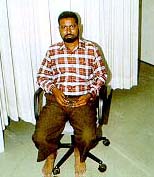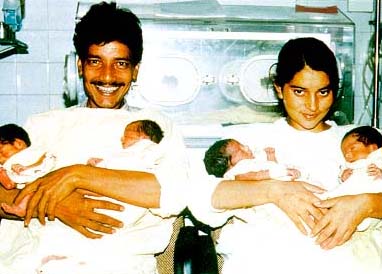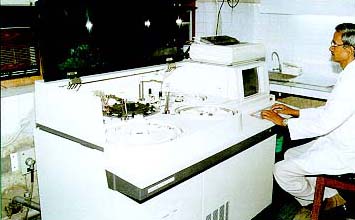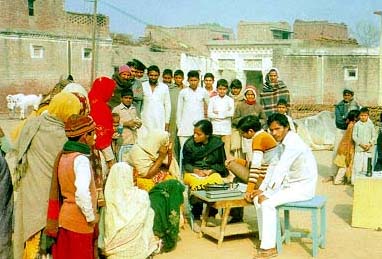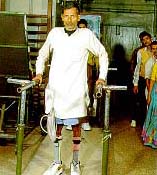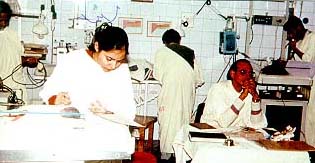Director's Office
- Details
- Last Updated on Wednesday, 24 December 2014 12:36
| Name | Telephone Number |
|---|---|
| Mr. P.K. Eldhose, P.S. | 91-11-26588000
4800, 4805 |
| Mr. Unni Krishna Varma , P.A. | |
| Ms. Pratibha, Steno | |
| Mr. Amarjeet Singh, D.E.O |
- Details
- Last Updated on Monday, 08 May 2023 10:26
Our results in sophisticated medical and surgical care among the best in the world.The most satisfying aspect of this endeavour is that these cutting-edge modalities are being actually used for the poor.
|
AIIMS strives hard to make world class clinical care available to millions of underprivileged citizens of India and neighboring countries. While its magnificent buildings and hi-tech facilities may create a superficial image of elitism, a visit to AIIMS is enough to dispel any such illusion Its corridors are thronged by patients, most of them too poor to afford quality treatment elsewhere. They come here with high hopes because of the reputation which AIIMS as built up. AIIMS is at present, not a single hospital but a conglomerate of facilities .It has over 1500 spread over the main hospital, Dr. Rajendra Prasad Centre for Ophthalmic sciences, Cardiothoracic Centre, Neurosciences Centre, Institute Rotary Centre Hospital and De-addiction Centre. This complex of facilities caters to about 1.5 million outpatients and 80,000 inpatients every year .The number of surgical operations performed at AIIMS last year was over 100,000. |

Coronary bypass surgery in progress at Cardiothoracic Centre, AIIMS |
|
Shri Devi Ram, the first heart transplant patient in India, operated on 3 August 1994 at AIIMS. |
However, the strength of AIIMS lies not in numbers, but in availability under one roof of the best team of medical and surgical experts, state-of-the-art equipment, and our capacity to rise to the occasion to meet diagnostic or public health challenges.Be it the autoanalyser or the linear accelerator,magnetic resonance imaging or the gamma knife, AIIMS has them all. Once something new arrives on the scene,someone, somewhere in the Institute takes the initiative and musters the energy and drive required to get it |
|
Among the areas pioneered by AIIMS are cardiac catheterization,heart valve surgery, porto-caval surgery, neonatal surgery,jointreplacement, cochlear implant and multi organ transplants (cornea, kidney,bone marrow,heart and liver).Our results in sophisticated medical and surgical care are among the best in the world. The most satisfying aspect of this endeavour is that these cutting- edge modalities are being actually used for is that poor. |
|
|
|
The role of AIIMS in patient care is not confined to our own hospital.AIIMS has trained physicians and surgeons who have fanned out across the country and abroad.For decades a large proportion of neurologists, neurosurgeons, cardiac surgeons, paediatric surgeons and gastroenterologists were from AIIMS,simply because we were the first to start courses in these superspecialities.New we have D M courses also in endocrinology and medical oncology.The nation has invested heavily in AIIMS from its doubt that AIIMS meager resources in an attempt to provide the best possible health care to its people irrespective of their paying capacity. Few would has fulfilled its commitment. |
|
BCR green signals ABL red signals Arrows show fusion signals |
|
|
An interphase cell from a Philadelphia Chromosome positive patient having chronic myeloid leukemia.The cellshows b c r/ a b/chimeric fusion gene(oncogene). The yellow signal represents overlapping of b c r green)and a b/ (red) signals. |
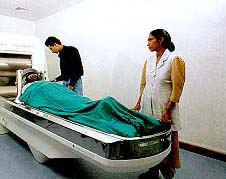 |
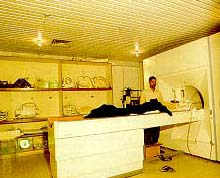 |
|
A neurosurgical patient being prepared for treatment with the recetly installed gamma knife |
A patient undergoing investigation at the state-of-the-art Magnetic Resonance Imaging facility of AIIMS. |
|
|
A multichannal autoanalyser which can give quick estimation of several parameters of blood chemistry using a very small blood sample. |
Extension Services
|
The comprehensive rural health services project (CRHSP) was at established, ballabgarh, about 35 km from AIIMS, to serve as a model for delivery of health care to the villages of india. It consist of a subdivisional hospitals and network of a primary health centres, subcentres and health workers. Its unique feature is a strong element of participation of the community in its own care. The project has demonstrated their major improvement in health can be achieved with modest resources. |
 Mrs.Renuka Chowdhury,Minister of Health & Family Welfare and President of AIIMS, looking at some posters at an exhibition on Lifestyle and Health after inaugurating it at AIIMS on 25 september 1997. |
|
|
Most of the health indices set as a goals for the country for the year 2000 have already been achieved in the ballabgarh block. The infant morality rate in CRHSP is 54.6 per 1000 live births per year against the national average is 74.There are no maternal deaths in this population against a national figure of 200-400 per 1,00,000 live births per year. Immunization coverage of children and pregnant women is over 95% as is the coverage for vitamin A, ORT use during diarrhea and early appropriate treatment of pneumonia in children. |
| Extension activities of AIIMS include a model community-based urban health project and a De-addiction Centres. |
|
Teaching
- Details
- Last Updated on Friday, 28 October 2016 11:34
Information Pertaining to Academic Section for the year 2013-2014
No. of students On-Roll in various courses at AIIMS as on 31/3/2014:
| 1. | MBBS Students | - | 383 |
| 2. | B.Sc. (Hons.)Nursing Students
|
- | 393 |
| 3. | MD,MS,MDS,MHA & M.Ch.(6 years) Students | - | 655 |
| 4. | DM & MCH Students | - | 224 |
| 5. | Ph. D. Students | - | 419 |
| 6. | M.Sc., M.Sc. Nursing & M.Biotechnology Students |
- | 109 |
No. of students who have been awarded degrees till 41st Convocation held in 2013: |
|||
| 1. | MBBS | - | 2646 |
| 2. | B.Sc.(Hons.) Nursing, | - | 2674 |
| 3. | MD,MS,MDS,MHA & M.Ch. (6 years) | - | 5198 |
| 4. | DM & MCH | - | 1344 |
| 5. | Ph. D. | - | 996 |
| 6. | M.Sc., M.Sc. Nursing
& M. Biotechnology |
- | 764 |
|
AIIMS runs a variety of undergraduate courses in medicine, nursing and related areas , and postgraduate courses in virtually all the basic and clinical medicalspecialties and superspecialties. Admissions to these courses are based on entrance examinations conducted all over the country |
The various courses of study offered by AIIMS |
|
The AIIMS offers various courses at different levels. All in all 42 disciplines are taught at AIIMS. The different categories include :
|
Undergraduate Courses (UG) |
Postgraduate Courses (PG) |
| MBBS | MD,MS & MDS |
| B.Sc.(Hons.)Human Biology: | DM & MCh |
| B.Sc.Courses in Nursing, Audiometry,Ophthalmic, Techniques and Radiography | Master's Degree in Science (M Sc) |
| Master's Degree in Biotechnology (M Biotech) | |
| Doctor of Philosophy (Ph D) |
Undergraduate Courses
MBBS
|
50 students are admitted each year to the MBBS course of AIIMS. Our MBBS students are a carefully selected group of remarkably able and intelligent students committed to a high sustained hard work is the norm. What they need is only a little guidance along the path to knowledge. All efforts are made to keep their initiative and curiosity alive by making them active participants in the teaching-learning process. They also have an opportunity to stretch their minds with research during their vacations. The faculty is willing andeager to provide vent to the wealth of ideas and energy available with this endless streamof extremely curious and committed young people. However, since they skills for the being are trained for practicing medicine, we ensure that they do acquire the purpose. Further, the science and craft of medicine should be accompanied by a humane approach to illness. To inculcate the necessary empathy in our students, our curriculum extends beyond medicine, and encroaches on science and psychology. In short, undergraduate medical education is a blend of several streams of competing, and sometimes conflicting, endeavours. We try and make the blend as harmonious as We wish to produce competent and caring doctors while at the same time stimulating the creative abilities of our students It is not surprising that AIIMS was judged the best medical in India in the INDIA TODAY-ORG-MARG poll conducted in 1997. |

A student receiving her degree from the Minister & president of AIIMS, Mr. Saleem Iqbal Shervani. |
B.Sc. Courses in Nursing, Audiometry, Ophthalmic, Techniques and Radiography:
|
These undergraduate courses are designed to produce well quailed personnel without whom no health care team can be complete. |
Objective structure Clinical Examination (O S C E) in neonatology in progress. |
Postgraduate Courses
MD, MS & MDS:
|
All postgraduate students in AIIMS are potential teachers and research workers. Hence during their stay at the Institute, they not only acquire competence in a branch of medicine or surgery, but they also savor the romance of teaching and research. The small pieces of research which postgraduate students complete are treated as guided introduction to the painfully slow and tedious process of discovery. AIIMS is also one of the pioneers in initiating an in-service training programme for postgraduate students. Residents, while providing patient care, also get formal training and education towards their degrees. Atpresent the Institute awards postgraduate degrees in 55 different specialties. |
DM & MCh:
AIIMS also offers superspecialty courses in a large number of medical and surgical disciplines (DM and MCh respectively such as):
| Cardiology | Gastroenterology |
| Cardiothoracic Surgery | Endocrinology |
| Neurology | Nephrology |
| Neurosurgery | Nedical oncology |
| Pediatric Surgery |
Master's degree in science (M Sc):
Master's degree in Biotechnology (M Biotech):
|
This two year course was started in 1986. This new venture in an emerging discipline has been designed to produce a cadre of scientists required for highly specialized areas such as vaccine production. |
Doctor of Philosophy
| Ph D students conduct an extensive piece of research of high quality on which they may take upto 5 years. While in MD/MS and M Sc/M Biotech courses the emphasis is on breadth, in Ph D the emphasis is on depth. The students delve deep into a narrow area to which they may stick for a lifetime. |
- Details
- Last Updated on Monday, 08 May 2023 10:18
AIIMS AT GLANCE
Information Pertaining to Academic Section for the year 2013-2014
No. of students On-Roll in various courses at AIIMS as on 31/3/2014:
| 1. | MBBS Students | - | 383 |
| 2. | B.Sc. (Hons.)Nursing Students
|
- | 393 |
| 3. | MD,MS,MDS,MHA & M.Ch.(6 years) Students | - | 655 |
| 4. | DM & MCH Students | - | 224 |
| 5. | Ph. D. Students | - | 419 |
| 6. | M.Sc., M.Sc. Nursing & M.Biotechnology Students |
- | 109 |
No. of students who have been awarded degrees till 41st Convocation held in 2013: |
|||
| 1. | MBBS | - | 2646 |
| 2. | B.Sc.(Hons.) Nursing, | - | 2674 |
| 3. | MD,MS,MDS,MHA & M.Ch. (6 years) | - | 5198 |
| 4. | DM & MCH | - | 1344 |
| 5. | Ph. D. | - | 996 |
| 6. | M.Sc., M.Sc. Nursing
& M. Biotechnology |
- | 764 |
Cornea Transplantation waiting list
- Details
- Last Updated on Wednesday, 08 October 2014 10:33
National Eye Bank Transplantation Services
Dr. Rajendra Prasad Centre for Ophthalmic Sciences
All India Institute of Medical Sciences
Recipient waiting list as per records maintained in National Eye Bank till 30.04.2013
| Patients | Letter sent to Patients with registration number | Patients still waiting for call | No. of patients waiting |
|---|---|---|---|
| Children below 6 years of age | Upto E-2680 / date 13/03/13 | 00 | 00 |
| Children between 6-12 years and Adult with blindness in both eyes | Upto TP-8823 / Date 11/04/13 | 8824 to 8853 | 29 |
| Adult with Visual impairment in both eyes | Upto P-4500 / date 14/03/13 | 4501 to 4513 | 12 |
| Adult with blindness in one eye | Upto G-13095 / date 01/06/12 | 13096 to 13637 | 541 |
- Additional patients who need emergency surgery are around 15 per month.
- No. of corneal transplants done in May = 102
- There are also several patients admitted in the ward waiting for surgery and more patients waiting for
- admission by the corneal transplant teams.
Dr. Radhika Tandon
Officer-in-charge
National Eye Bank.
More Articles...
Subcategories
Contact Us
All India Institute of Medical Sciences
Ansari Nagar, New Delhi - 110029
Board Number : +91-11-26588500 / 26588700
Fax : +91-11-26588663 / 26588641




